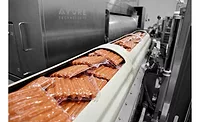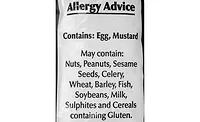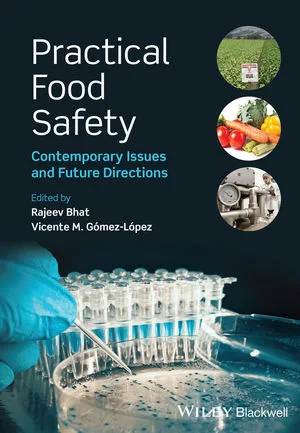Fresh-Cuts Are Popular, Any Way You Slice Them

Convenient, packaged fresh-cut fruits and vegetables are showing up in more and more consumer markets. Ready-to-eat sliced apples, for example, are now being offered by fast-food chains and school cafeterias. With high fiber and low calorie content, precut produce provides busy consumers with healthful options while on the go.
At the U.S. Department of Agriculture Agricultural Research Service (USDA ARS) Produce Quality and Safety Laboratory (PQSL), in Beltsville, MD, several research projects and studies have led to findings that will benefit processors, package manufacturers, distributors and grocers.
“Maintaining consumer acceptance of fresh-cut fruits and vegetables after processing and throughout distribution is a challenge to the fresh-cut industry,” says Kenneth C. Gross, a plant physiologist who heads the PQSL. “We’re conducting research to help find ways to widen the variety of offerings that stay fresh to the last bite.”
Where Package Meets Product
Package wraps, called “films,” that cover precut produce appear to simply offer containment. But today’s package films are more than mere coverings. And the choice of film depends on the produce variety being wrapped.
Each film has an oxygen transmission rate, which allows cut produce to continue “breathing” throughout storage and distribution. Hundreds of different films have been manufactured, each with unique permeability levels. This feature must be matched with a particular fruit or vegetable variety’s requirements. Another important feature is the amount of oxygen that is infused into a package before sealing.
The key to maintaining quality and prolonging shelf life is to create the exact balance of oxygen and carbon dioxide inside a package. This technology, known as modified atmosphere packaging (MAP), allows fresh-cut produce to respire slowly and stay fresh during the longest possible storage time.
PQSL food technologist Yaguang Luo has studied the oxygen and carbon dioxide transmission rates of package films and how they affect the produce inside (Photo 1). “Fresh-cut fruits and vegetables are alive, and different varieties respire at different rates. It is critical to match the right oxygen permeation level to the respiration rate of the particular produce being wrapped,” she says. “With lettuce, for example, if the oxygen transmission rate of the package film is too high, it will cause the product to brown. If it is too low, it will cause decay.”
Cilantro, a fresh-cut culinary herb known as a key flavor component of salsa, has a high respiration rate, making shelf life a challenge. Leaf yellowing, dehydration and loss of aroma can set in quickly after cutting. Luo has identified a packaging film for cilantro that supports a 14-day shelf life. Using advanced packaging and other technologies, Luo has prolonged quality and shelf life of romaine lettuce, iceberg lettuce, carrots, and a nutritious new vegetable, Salad Savoy, that is a close relative of kale and cabbage (Photos 2-4).
Alternatives to a Chlorine Wash
PQSL plant pathologist James McEvoy and Luo teamed up to successfully use acidified sodium chlorite (ASC) as a sanitizing agent on cut carrots. The chemical had previously been found to degrade produce. But by working with specific concentrations and dipping times, the team developed an ASC treatment that reduced the human pathogen E. coli O157:H7 on cut carrots by 99.999 percent. ASC was also found to remove the bacteria that cause spoilage on carrots.

The specific formula and methodology holds promise as an alternative to the chlorine rinses many processors use to control microorganism growth on fresh-cut produce.

Luo has received industry funding to work on maintaining produce freshness by slowing down the ripening process with a gas treatment, 1-methylcyclopropene (1-MCP), alone or in combination with ASC. She has found that exposing cilantro to 1-MCP before cutting and then dipping it in ASC after cutting prolongs quality and slows decay when matched with the right film.
Luo, McEvoy and PQSL plant physiologist Robert Saftner have also used 1-MCP to keep watermelon fresh. 1-MCP accomplishes this process by playing a trick on ethylene action. Ethylene is a hormone that is produced by plants, but it degrades quality in watermelon. Ethylene performs this function by binding to chemical receptors within the plant. A molecule of 1-MCP is so small that it penetrates the rind of watermelon and other produce. After entering the fruit’s flesh, 1-MCP competes with ethylene by binding to the same receptors as ethylene. Ethylene, then, is blocked from binding to the receptors. This mechanism slows down degradation in quality, which can buy extra time for shipping and prolong a product’s selling season.
New Arrivals in the Melon Industry
Packaged fresh-cut melons are among the most common fresh-cut fruits available year round in the marketplace. But they come with particular quality and shelf-life challenges.
Saftner and retired PQSL horticulturist Judith Abbott have identified melon varieties with improved flavor and texture that will benefit the North American fresh-cut melon industry. They collaborated with ARS plant physiologist Gene E. Lester, of the Crop Quality and Fruit Insects Research Unit in Weslaco, TX, and found that orange-fleshed honeydew melons can provide an appealing alternative to cantaloupes for fresh cutting (Photo 5).
Saftner’s team compared the quality, shelf life and consumer acceptance of fresh-cut cantaloupe with green- and orange-fleshed honeydews. “We found that consumers liked the flavor, texture, sweetness and overall quality of the orange-fleshed honeydew chunks as well as, or better than, chunks of cantaloupe and green-fleshed honeydews,” says Saftner.
Cantaloupe and some other orange-fleshed melon varieties have netted rinds, which provide surface nooks and crannies that can harbor pathogens. Among the smooth-rinded, orange-fleshed honeydews tested, Orange Dew scored highest in appearance and nutritional value. It had the highest beta-carotene concentration, color saturation, and orange hue. Another smooth-rinded variety, Temptation, scored highest in flavor and overall eating quality. It also scored highest in melon aroma of all those tested.
“Because these orange-fleshed honeydew varieties are generally sweeter than cantaloupe and have a higher nutrient content than traditional green-fleshed varieties after being cut, they are a promising new melon type for fresh-cut processing,” Saftner says.
To Keep Browning at Bay
Dips, coatings, and sanitizers are also important in maintaining the quality of fresh-cut produce. The optimal concentrations of these solutions vary, depending on the product for which they are used. Several such treatment solutions developed at PQSL provide both antibrowning and antimicrobial benefits to apple slices and perhaps other produce.
Sliced apples are particularly in demand by retail foodservice operators and school foodservice directors. Current treatments allow a shelf life of up to about three weeks. Saftner, Abbott, and PQSL microbiologist Arvind Bhagwat tested a commercially used calcium ascorbate dip—developed by ARS—that prevents browning on slices of sanitized apples and compared it with three PQSL-developed dips (Photo 6).

Ten volunteers tasted four slices of Fuji and four slices of Granny Smith apples (Photo 7). Each slice had been dipped that day in one of the four treatments. The testers tasted for changes in the apple slice’s aroma and flavor and rated those dipped in the PQSL solutions as good as those treated with the commercial wash. All four treatments were found to maintain the apple slices’ cut-surface color, firmness, aroma, and flavor similarly.
In a separate test, the researchers exposed five pathogens to fresh batches of each of the same four antibrowning washes for two hours. Formula PQSL 2.0 reduced levels of all five pathogens in the wash solutions by 99.999 percent. In addition, the same dip, PQSL 2.0, came out ahead of the calcium ascorbate treatment in reducing microflora on sanitized apples after slicing. Such native bacterial and fungal populations can accelerate spoilage.
“We also found that the wash solutions lost their antimicrobial activity over time,” says Saftner. “Wash solutions should not be reused on multiple batches of sliced apples.” The researchers emphasized the importance of ongoing work to find ways of maintaining the antimicrobial properties of wash treatments, such as adjusting the acid level and switching to one-use sprays.
More recent studies have shown that a newer PQSL wash treatment eliminated two pathogens—Listeria and Salmonella—on apple slices. “We purposely infected apple slices with low doses of these two pathogens and found that after one, two and three weeks, they’d been completely eliminated on the slices that had been treated with the new formula,” says Saftner. “These results are a significant development in keeping sliced apples both fresh and safe.”
Rosalie Marion Bliss is with the Agricultural Research Service Information Staff. This research is part of Quality and Utilization of Agricultural Products (#306), Food Safety (#108), and Plant Diseases (#303), three ARS National Programs described on the World Wide Web at www.nps.ars.usda.gov. “Fresh-Cuts Are Popular, Any Way You Slice Them” was first published in the July 2006 issue of Agricultural Research magazine.
Looking for quick answers on food safety topics?
Try Ask FSM, our new smart AI search tool.
Ask FSM →







